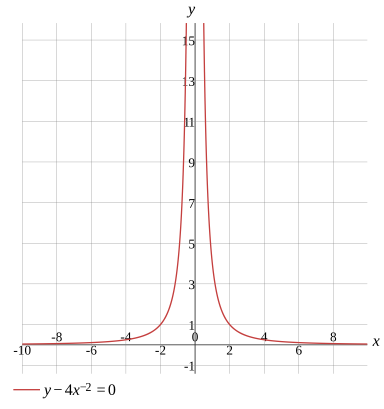Question
Function
Find the x-intercept/zero
Find the y-intercept
No x-intercept
Evaluate
y−4x−2=0
To find the x-intercept,set y=0
0−4x−2=0
Removing 0 doesn't change the value,so remove it from the expression
−4x−2=0
Rewrite the expression
x2−4=0
Cross multiply
−4=x2×0
Simplify the equation
−4=0
The statement is false for any value of x
x∈∅
Solution
No x-intercept
Show Solution

Solve the equation
Solve for x
Solve for y
x=−∣y∣2y,y=0x=∣y∣2y,y=0
Evaluate
y−4x−2=0
Move the expression to the right-hand side and change its sign
−4x−2=0−y
Removing 0 doesn't change the value,so remove it from the expression
−4x−2=−y
Rewrite the expression
More Steps


Evaluate
−4x−2
Express with a positive exponent using a−n=an1
−4×x21
Rewrite the expression
x2−4
Use b−a=−ba=−ba to rewrite the fraction
−x24
−x24=−y
Rewrite the expression
x2−4=−y
Cross multiply
−4=x2(−y)
Simplify the equation
−4=−yx2
Evaluate
4=yx2
Swap the sides of the equation
yx2=4
Divide both sides
yyx2=y4
Divide the numbers
x2=y4
Take the root of both sides of the equation and remember to use both positive and negative roots
x=±y4
Simplify the expression
More Steps


Evaluate
y4
To take a root of a fraction,take the root of the numerator and denominator separately
y4
Simplify the radical expression
More Steps


Evaluate
4
Write the number in exponential form with the base of 2
22
Reduce the index of the radical and exponent with 2
2
y2
Multiply by the Conjugate
y×y2y
Calculate
∣y∣2y
x=±∣y∣2y
Separate the equation into 2 possible cases
x=∣y∣2yx=−∣y∣2y
Calculate
{x=−∣y∣2yy=0{x=∣y∣2yy=0
Solution
x=−∣y∣2y,y=0x=∣y∣2y,y=0
Show Solution

Testing for symmetry
Testing for symmetry about the origin
Testing for symmetry about the x-axis
Testing for symmetry about the y-axis
Not symmetry with respect to the origin
Evaluate
y−4x−2=0
To test if the graph of y−4x−2=0 is symmetry with respect to the origin,substitute -x for x and -y for y
−y−4(−x)−2=0
Evaluate
−y−4x−2=0
Solution
Not symmetry with respect to the origin
Show Solution

Rewrite the equation
r=3cos2(θ)sin(θ)34
Evaluate
y−4x−2=0
Rewrite the expression
More Steps


Evaluate
−4x−2
Express with a positive exponent using a−n=an1
−4×x21
Rewrite the expression
x2−4
Use b−a=−ba=−ba to rewrite the fraction
−x24
y−x24=0
Multiply both sides of the equation by LCD
(y−x24)x2=0×x2
Simplify the equation
More Steps


Evaluate
(y−x24)x2
Apply the distributive property
yx2−x24×x2
Simplify
yx2−4
yx2−4=0×x2
Any expression multiplied by 0 equals 0
yx2−4=0
To convert the equation to polar coordinates,substitute x for rcos(θ) and y for rsin(θ)
sin(θ)×r(cos(θ)×r)2−4=0
Factor the expression
sin(θ)cos2(θ)×r3−4=0
Simplify the expression
cos2(θ)sin(θ)×r3−4=0
Subtract the terms
cos2(θ)sin(θ)×r3−4−(−4)=0−(−4)
Evaluate
cos2(θ)sin(θ)×r3=4
Divide the terms
r3=cos2(θ)sin(θ)4
Solution
r=3cos2(θ)sin(θ)34
Show Solution

Find the first derivative
Find the derivative with respect to x
Find the derivative with respect to y
dxdy=−x38
Calculate
y−4x−2=0
Take the derivative of both sides
dxd(y−4x−2)=dxd(0)
Calculate the derivative
More Steps


Evaluate
dxd(y−4x−2)
Use differentiation rules
dxd(y)+dxd(−4x−2)
Evaluate the derivative
More Steps


Evaluate
dxd(y)
Use differentiation rules
dyd(y)×dxdy
Use dxdxn=nxn−1 to find derivative
dxdy
dxdy+dxd(−4x−2)
Evaluate the derivative
More Steps


Evaluate
dxd(−4x−2)
Use differentiation rule dxd(cf(x))=c×dxd(f(x))
−4×dxd(x−2)
Use dxdxn=nxn−1 to find derivative
−4(−2x−3)
Multiply the terms
8x−3
dxdy+8x−3
dxdy+8x−3=dxd(0)
Calculate the derivative
dxdy+8x−3=0
Move the expression to the right-hand side and change its sign
dxdy=0−8x−3
Removing 0 doesn't change the value,so remove it from the expression
dxdy=−8x−3
Solution
More Steps


Evaluate
−8x−3
Express with a positive exponent using a−n=an1
−8×x31
Calculate the product
−x38
dxdy=−x38
Show Solution

Find the second derivative
Find the second derivative with respect to x
Find the second derivative with respect to y
dx2d2y=x424
Calculate
y−4x−2=0
Take the derivative of both sides
dxd(y−4x−2)=dxd(0)
Calculate the derivative
More Steps


Evaluate
dxd(y−4x−2)
Use differentiation rules
dxd(y)+dxd(−4x−2)
Evaluate the derivative
More Steps


Evaluate
dxd(y)
Use differentiation rules
dyd(y)×dxdy
Use dxdxn=nxn−1 to find derivative
dxdy
dxdy+dxd(−4x−2)
Evaluate the derivative
More Steps


Evaluate
dxd(−4x−2)
Use differentiation rule dxd(cf(x))=c×dxd(f(x))
−4×dxd(x−2)
Use dxdxn=nxn−1 to find derivative
−4(−2x−3)
Multiply the terms
8x−3
dxdy+8x−3
dxdy+8x−3=dxd(0)
Calculate the derivative
dxdy+8x−3=0
Move the expression to the right-hand side and change its sign
dxdy=0−8x−3
Removing 0 doesn't change the value,so remove it from the expression
dxdy=−8x−3
Rewrite the expression
More Steps


Evaluate
−8x−3
Express with a positive exponent using a−n=an1
−8×x31
Calculate the product
−x38
dxdy=−x38
Take the derivative of both sides
dxd(dxdy)=dxd(−x38)
Calculate the derivative
dx2d2y=dxd(−x38)
Use differentiation rules
dx2d2y=−8×dxd(x31)
Rewrite the expression in exponential form
dx2d2y=−8×dxd(x−3)
Use dxdxn=nxn−1 to find derivative
dx2d2y=−8(−3x−4)
Rewrite the expression
dx2d2y=−8(−x43)
Solution
dx2d2y=x424
Show Solution

Graph
